University Healthcare Cost Reduction Strategies Practicum Report
VerifiedAdded on 2021/04/24
|5
|1146
|19
Report
AI Summary
This report, focusing on healthcare cost reduction, analyzes five key strategies to curb expenses by reducing waste in resources. The strategies include implementing robust information systems to identify low-value care, establishing transparent adverse event reporting systems, utilizing information and behavior change programs, adhering to hospital and clinical guidelines, and leveraging financial incentives. Each strategy's dissemination process is outlined, including how hospitals can communicate these strategies to patients and staff. The report provides a balanced view by detailing the pros and cons of each approach, along with the necessary tools for successful implementation, such as financial subsidies, advertising, meeting minutes, and government communication. The report references several academic sources to support its findings, offering a comprehensive overview of cost-saving strategies in the healthcare sector.
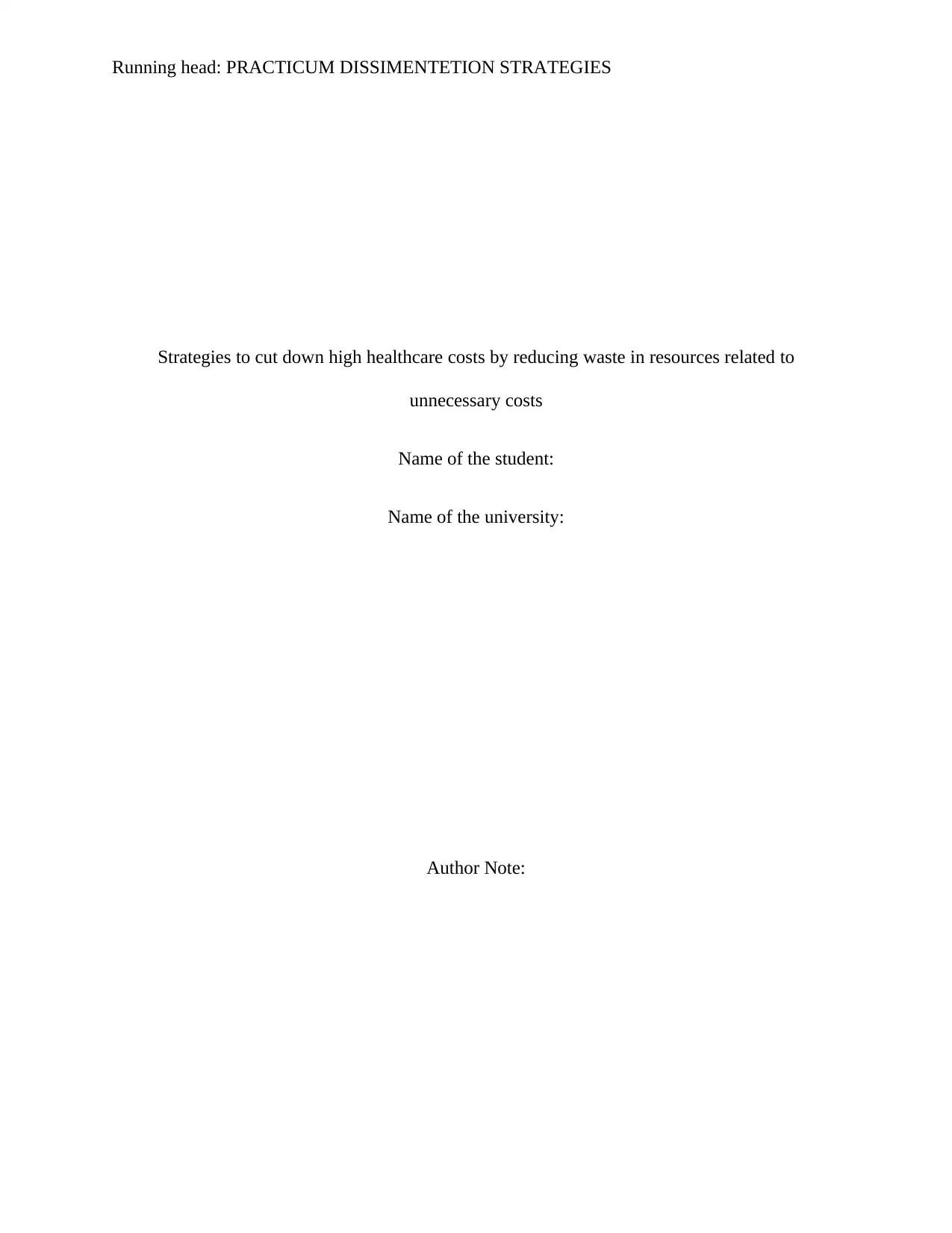
Running head: PRACTICUM DISSIMENTETION STRATEGIES
Strategies to cut down high healthcare costs by reducing waste in resources related to
unnecessary costs
Name of the student:
Name of the university:
Author Note:
Strategies to cut down high healthcare costs by reducing waste in resources related to
unnecessary costs
Name of the student:
Name of the university:
Author Note:
Paraphrase This Document
Need a fresh take? Get an instant paraphrase of this document with our AI Paraphraser
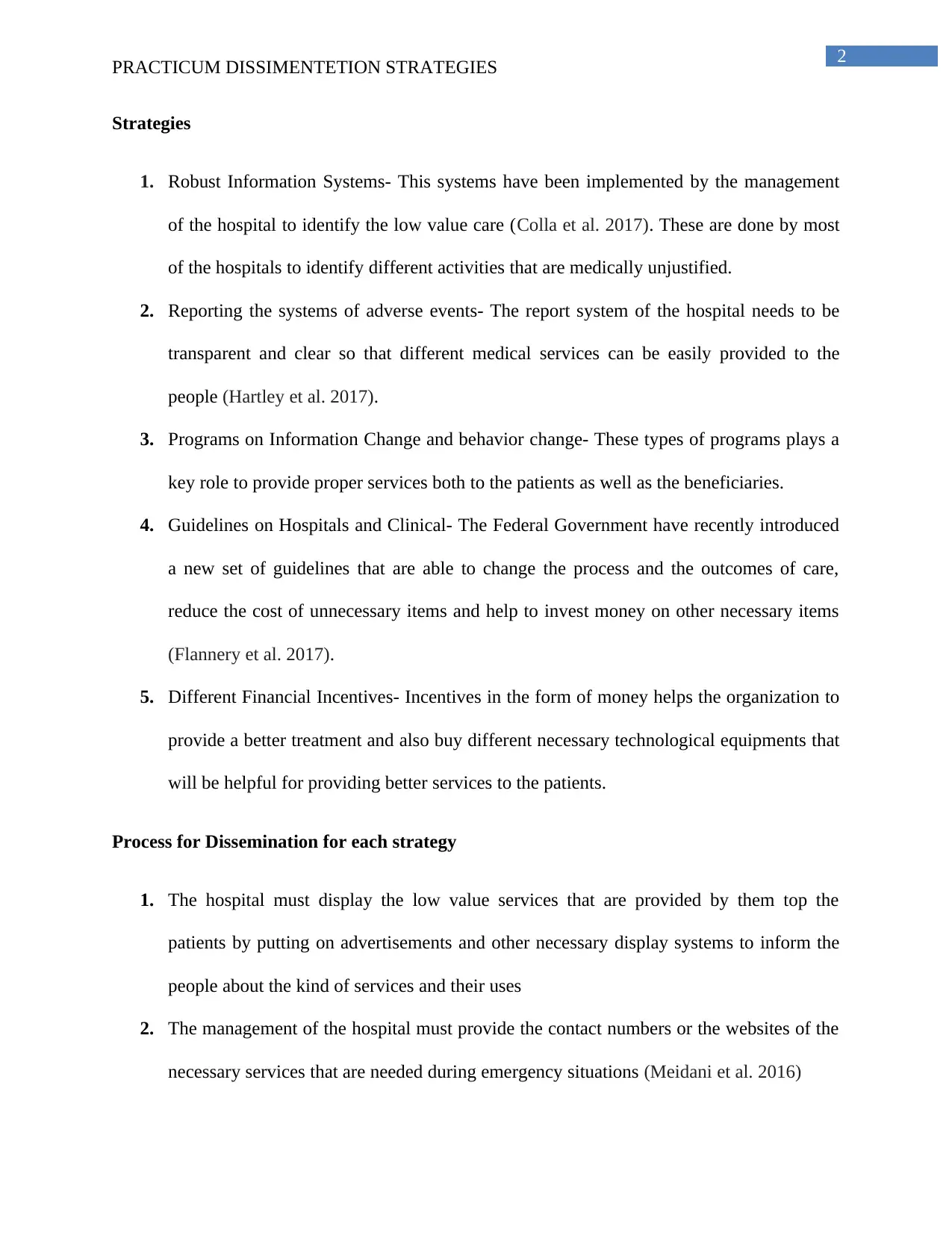
2
PRACTICUM DISSIMENTETION STRATEGIES
Strategies
1. Robust Information Systems- This systems have been implemented by the management
of the hospital to identify the low value care (Colla et al. 2017). These are done by most
of the hospitals to identify different activities that are medically unjustified.
2. Reporting the systems of adverse events- The report system of the hospital needs to be
transparent and clear so that different medical services can be easily provided to the
people (Hartley et al. 2017).
3. Programs on Information Change and behavior change- These types of programs plays a
key role to provide proper services both to the patients as well as the beneficiaries.
4. Guidelines on Hospitals and Clinical- The Federal Government have recently introduced
a new set of guidelines that are able to change the process and the outcomes of care,
reduce the cost of unnecessary items and help to invest money on other necessary items
(Flannery et al. 2017).
5. Different Financial Incentives- Incentives in the form of money helps the organization to
provide a better treatment and also buy different necessary technological equipments that
will be helpful for providing better services to the patients.
Process for Dissemination for each strategy
1. The hospital must display the low value services that are provided by them top the
patients by putting on advertisements and other necessary display systems to inform the
people about the kind of services and their uses
2. The management of the hospital must provide the contact numbers or the websites of the
necessary services that are needed during emergency situations (Meidani et al. 2016)
PRACTICUM DISSIMENTETION STRATEGIES
Strategies
1. Robust Information Systems- This systems have been implemented by the management
of the hospital to identify the low value care (Colla et al. 2017). These are done by most
of the hospitals to identify different activities that are medically unjustified.
2. Reporting the systems of adverse events- The report system of the hospital needs to be
transparent and clear so that different medical services can be easily provided to the
people (Hartley et al. 2017).
3. Programs on Information Change and behavior change- These types of programs plays a
key role to provide proper services both to the patients as well as the beneficiaries.
4. Guidelines on Hospitals and Clinical- The Federal Government have recently introduced
a new set of guidelines that are able to change the process and the outcomes of care,
reduce the cost of unnecessary items and help to invest money on other necessary items
(Flannery et al. 2017).
5. Different Financial Incentives- Incentives in the form of money helps the organization to
provide a better treatment and also buy different necessary technological equipments that
will be helpful for providing better services to the patients.
Process for Dissemination for each strategy
1. The hospital must display the low value services that are provided by them top the
patients by putting on advertisements and other necessary display systems to inform the
people about the kind of services and their uses
2. The management of the hospital must provide the contact numbers or the websites of the
necessary services that are needed during emergency situations (Meidani et al. 2016)
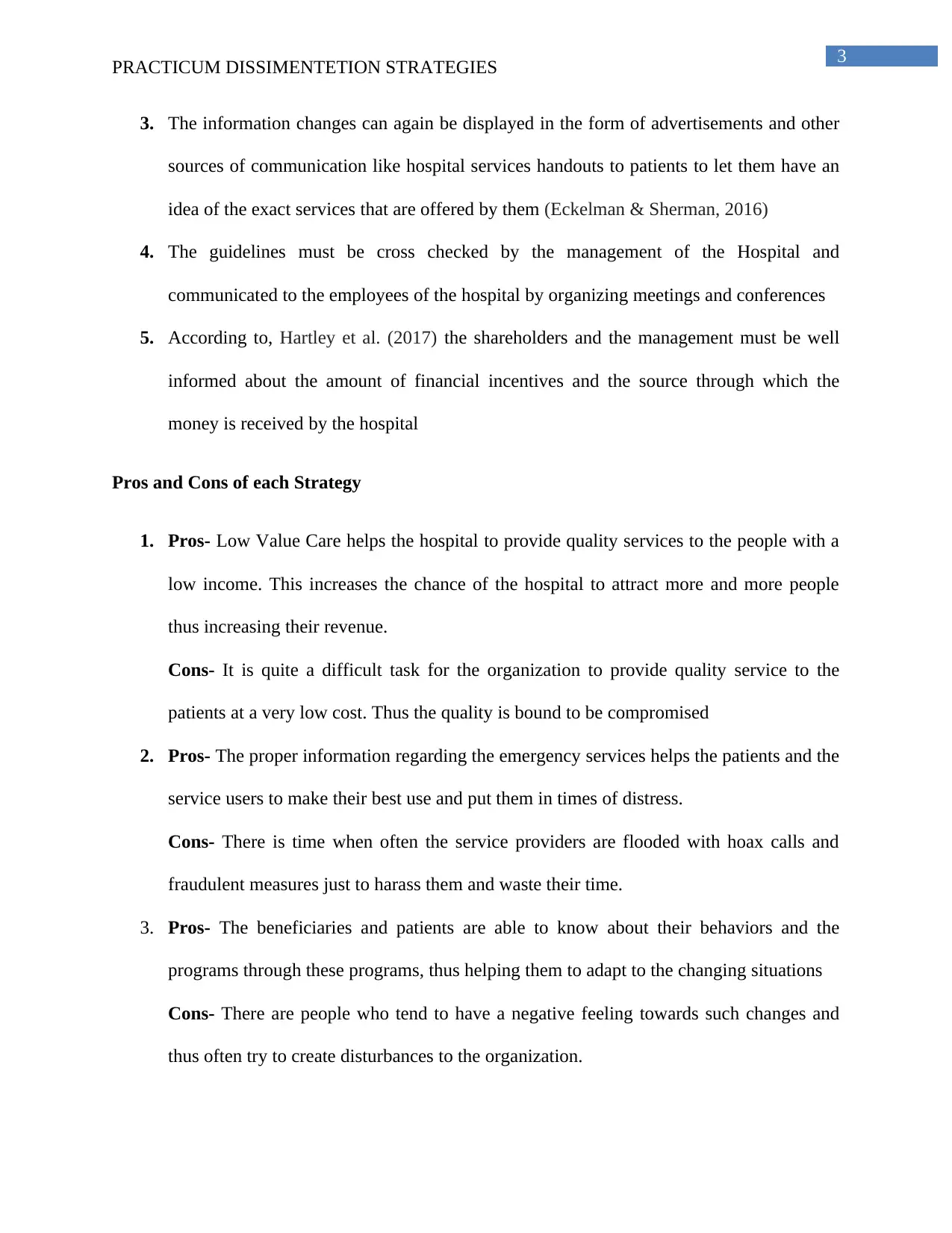
3
PRACTICUM DISSIMENTETION STRATEGIES
3. The information changes can again be displayed in the form of advertisements and other
sources of communication like hospital services handouts to patients to let them have an
idea of the exact services that are offered by them (Eckelman & Sherman, 2016)
4. The guidelines must be cross checked by the management of the Hospital and
communicated to the employees of the hospital by organizing meetings and conferences
5. According to, Hartley et al. (2017) the shareholders and the management must be well
informed about the amount of financial incentives and the source through which the
money is received by the hospital
Pros and Cons of each Strategy
1. Pros- Low Value Care helps the hospital to provide quality services to the people with a
low income. This increases the chance of the hospital to attract more and more people
thus increasing their revenue.
Cons- It is quite a difficult task for the organization to provide quality service to the
patients at a very low cost. Thus the quality is bound to be compromised
2. Pros- The proper information regarding the emergency services helps the patients and the
service users to make their best use and put them in times of distress.
Cons- There is time when often the service providers are flooded with hoax calls and
fraudulent measures just to harass them and waste their time.
3. Pros- The beneficiaries and patients are able to know about their behaviors and the
programs through these programs, thus helping them to adapt to the changing situations
Cons- There are people who tend to have a negative feeling towards such changes and
thus often try to create disturbances to the organization.
PRACTICUM DISSIMENTETION STRATEGIES
3. The information changes can again be displayed in the form of advertisements and other
sources of communication like hospital services handouts to patients to let them have an
idea of the exact services that are offered by them (Eckelman & Sherman, 2016)
4. The guidelines must be cross checked by the management of the Hospital and
communicated to the employees of the hospital by organizing meetings and conferences
5. According to, Hartley et al. (2017) the shareholders and the management must be well
informed about the amount of financial incentives and the source through which the
money is received by the hospital
Pros and Cons of each Strategy
1. Pros- Low Value Care helps the hospital to provide quality services to the people with a
low income. This increases the chance of the hospital to attract more and more people
thus increasing their revenue.
Cons- It is quite a difficult task for the organization to provide quality service to the
patients at a very low cost. Thus the quality is bound to be compromised
2. Pros- The proper information regarding the emergency services helps the patients and the
service users to make their best use and put them in times of distress.
Cons- There is time when often the service providers are flooded with hoax calls and
fraudulent measures just to harass them and waste their time.
3. Pros- The beneficiaries and patients are able to know about their behaviors and the
programs through these programs, thus helping them to adapt to the changing situations
Cons- There are people who tend to have a negative feeling towards such changes and
thus often try to create disturbances to the organization.
⊘ This is a preview!⊘
Do you want full access?
Subscribe today to unlock all pages.

Trusted by 1+ million students worldwide
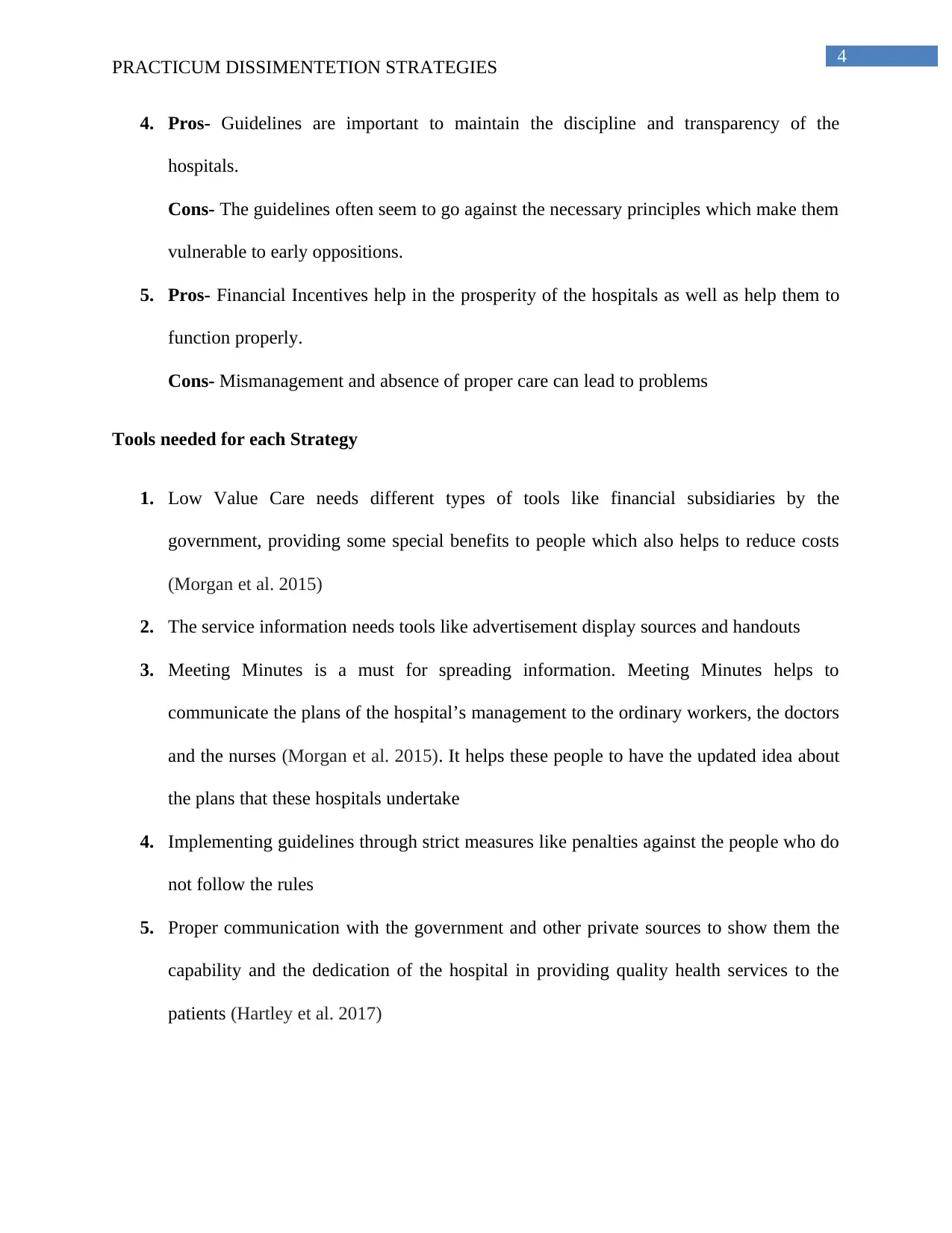
4
PRACTICUM DISSIMENTETION STRATEGIES
4. Pros- Guidelines are important to maintain the discipline and transparency of the
hospitals.
Cons- The guidelines often seem to go against the necessary principles which make them
vulnerable to early oppositions.
5. Pros- Financial Incentives help in the prosperity of the hospitals as well as help them to
function properly.
Cons- Mismanagement and absence of proper care can lead to problems
Tools needed for each Strategy
1. Low Value Care needs different types of tools like financial subsidiaries by the
government, providing some special benefits to people which also helps to reduce costs
(Morgan et al. 2015)
2. The service information needs tools like advertisement display sources and handouts
3. Meeting Minutes is a must for spreading information. Meeting Minutes helps to
communicate the plans of the hospital’s management to the ordinary workers, the doctors
and the nurses (Morgan et al. 2015). It helps these people to have the updated idea about
the plans that these hospitals undertake
4. Implementing guidelines through strict measures like penalties against the people who do
not follow the rules
5. Proper communication with the government and other private sources to show them the
capability and the dedication of the hospital in providing quality health services to the
patients (Hartley et al. 2017)
PRACTICUM DISSIMENTETION STRATEGIES
4. Pros- Guidelines are important to maintain the discipline and transparency of the
hospitals.
Cons- The guidelines often seem to go against the necessary principles which make them
vulnerable to early oppositions.
5. Pros- Financial Incentives help in the prosperity of the hospitals as well as help them to
function properly.
Cons- Mismanagement and absence of proper care can lead to problems
Tools needed for each Strategy
1. Low Value Care needs different types of tools like financial subsidiaries by the
government, providing some special benefits to people which also helps to reduce costs
(Morgan et al. 2015)
2. The service information needs tools like advertisement display sources and handouts
3. Meeting Minutes is a must for spreading information. Meeting Minutes helps to
communicate the plans of the hospital’s management to the ordinary workers, the doctors
and the nurses (Morgan et al. 2015). It helps these people to have the updated idea about
the plans that these hospitals undertake
4. Implementing guidelines through strict measures like penalties against the people who do
not follow the rules
5. Proper communication with the government and other private sources to show them the
capability and the dedication of the hospital in providing quality health services to the
patients (Hartley et al. 2017)
Paraphrase This Document
Need a fresh take? Get an instant paraphrase of this document with our AI Paraphraser
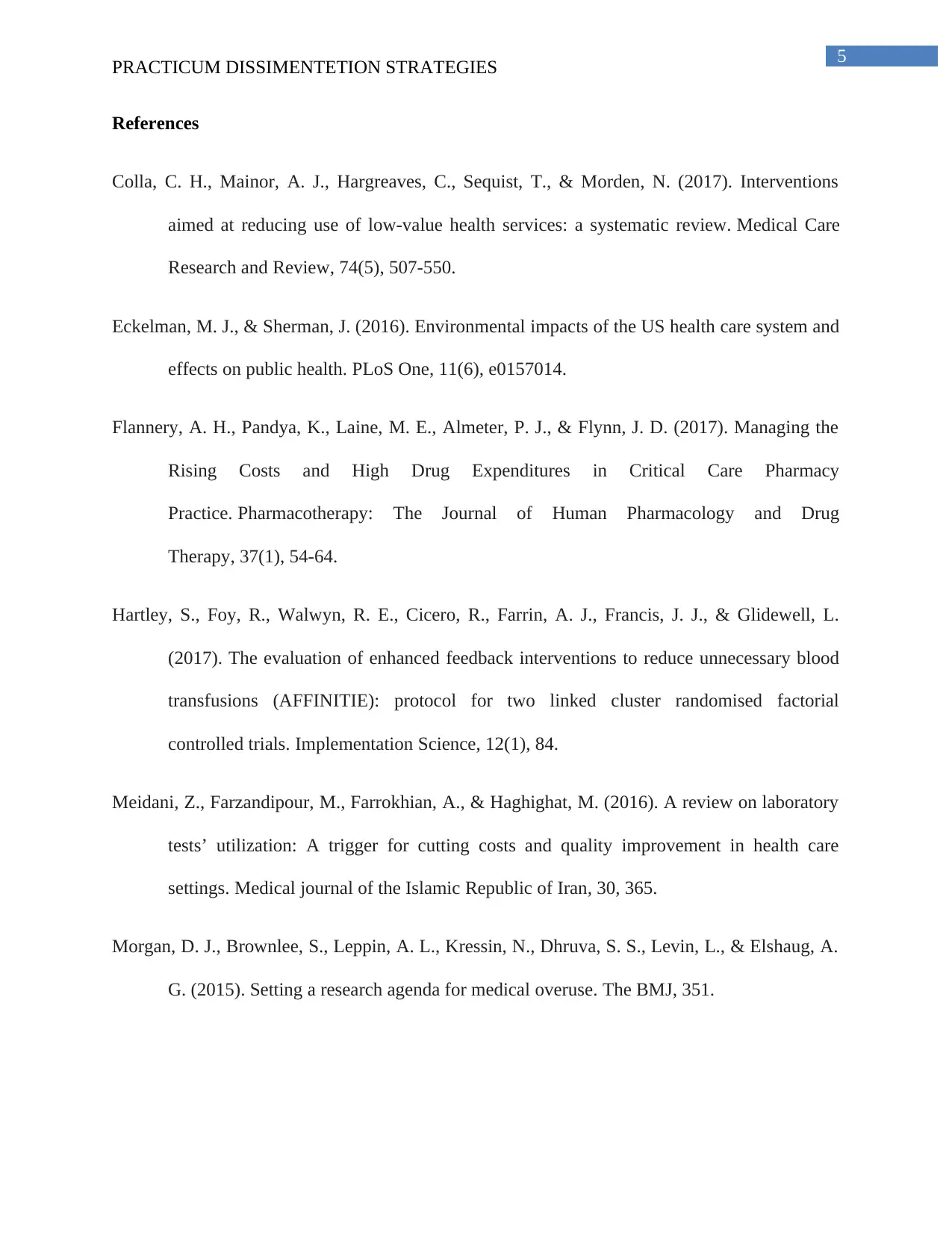
5
PRACTICUM DISSIMENTETION STRATEGIES
References
Colla, C. H., Mainor, A. J., Hargreaves, C., Sequist, T., & Morden, N. (2017). Interventions
aimed at reducing use of low-value health services: a systematic review. Medical Care
Research and Review, 74(5), 507-550.
Eckelman, M. J., & Sherman, J. (2016). Environmental impacts of the US health care system and
effects on public health. PLoS One, 11(6), e0157014.
Flannery, A. H., Pandya, K., Laine, M. E., Almeter, P. J., & Flynn, J. D. (2017). Managing the
Rising Costs and High Drug Expenditures in Critical Care Pharmacy
Practice. Pharmacotherapy: The Journal of Human Pharmacology and Drug
Therapy, 37(1), 54-64.
Hartley, S., Foy, R., Walwyn, R. E., Cicero, R., Farrin, A. J., Francis, J. J., & Glidewell, L.
(2017). The evaluation of enhanced feedback interventions to reduce unnecessary blood
transfusions (AFFINITIE): protocol for two linked cluster randomised factorial
controlled trials. Implementation Science, 12(1), 84.
Meidani, Z., Farzandipour, M., Farrokhian, A., & Haghighat, M. (2016). A review on laboratory
tests’ utilization: A trigger for cutting costs and quality improvement in health care
settings. Medical journal of the Islamic Republic of Iran, 30, 365.
Morgan, D. J., Brownlee, S., Leppin, A. L., Kressin, N., Dhruva, S. S., Levin, L., & Elshaug, A.
G. (2015). Setting a research agenda for medical overuse. The BMJ, 351.
PRACTICUM DISSIMENTETION STRATEGIES
References
Colla, C. H., Mainor, A. J., Hargreaves, C., Sequist, T., & Morden, N. (2017). Interventions
aimed at reducing use of low-value health services: a systematic review. Medical Care
Research and Review, 74(5), 507-550.
Eckelman, M. J., & Sherman, J. (2016). Environmental impacts of the US health care system and
effects on public health. PLoS One, 11(6), e0157014.
Flannery, A. H., Pandya, K., Laine, M. E., Almeter, P. J., & Flynn, J. D. (2017). Managing the
Rising Costs and High Drug Expenditures in Critical Care Pharmacy
Practice. Pharmacotherapy: The Journal of Human Pharmacology and Drug
Therapy, 37(1), 54-64.
Hartley, S., Foy, R., Walwyn, R. E., Cicero, R., Farrin, A. J., Francis, J. J., & Glidewell, L.
(2017). The evaluation of enhanced feedback interventions to reduce unnecessary blood
transfusions (AFFINITIE): protocol for two linked cluster randomised factorial
controlled trials. Implementation Science, 12(1), 84.
Meidani, Z., Farzandipour, M., Farrokhian, A., & Haghighat, M. (2016). A review on laboratory
tests’ utilization: A trigger for cutting costs and quality improvement in health care
settings. Medical journal of the Islamic Republic of Iran, 30, 365.
Morgan, D. J., Brownlee, S., Leppin, A. L., Kressin, N., Dhruva, S. S., Levin, L., & Elshaug, A.
G. (2015). Setting a research agenda for medical overuse. The BMJ, 351.
1 out of 5
Related Documents
Your All-in-One AI-Powered Toolkit for Academic Success.
+13062052269
info@desklib.com
Available 24*7 on WhatsApp / Email
![[object Object]](/_next/static/media/star-bottom.7253800d.svg)
Unlock your academic potential
Copyright © 2020–2025 A2Z Services. All Rights Reserved. Developed and managed by ZUCOL.





